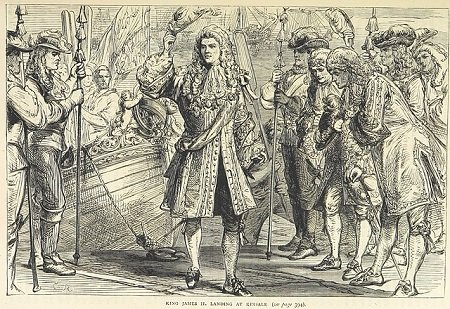Picture credit: Wikimedia
If you’re interested in the story of Jacobite King James - this article is the place for you.
Scottish history is rich, and many names deserve a mention. The full story of the Jacobite rebellion could be a book.
In this article, we take a closer look at a deposed king who inspired the Jacobites to take up the sword. Who was he, how did he become king, and why did he lose his seat of power?
Let’s focus on the story of King James, and his supporters, the Jacobites.
Who Was King James?
The history of the Jacobites will be forever tied to the history of this king. But who was he, and how did he inspire a nation to wage so many battles on behalf of his right to rule?
To understand the setting for the Jacobite uprisings, we need to look at the man who started it all.
James II’s Childhood And Background
James Stuart was born in October 1633, at St. James's Palace in London. The third son of King Charles I and Princess Henrietta Maria of France, young James received the title of The Prince of England, Scotland, France, and Ireland.
King James II Of England And Ireland
James Stuart, the son of King Charles I, became known as King James II of England and Ireland upon the death of his father.
The Story of King James Of The Jacobites
Picture credit: Wikimedia
When his elder brother Charles II died in 1685 with no legitimate heir, James II took the throne. In doing so, he also became King James VII of Scotland.
This has always been the practice of royal families, where the line of succession is passed down to the male heir. It is only if there is no male heir that a female heir could take the throne. So, in line with tradition, James was named king. However, he was not popular with all.
The Struggle For The British Throne
Escaping the parliamentary forces that would claim the life of his father in 1649, James lived in exile in the Low Countries and France until 1660. At this point, he returned to England with his brother King Charles II.
Later that same year, James married Anne Hyde, daughter of Edward Hyde, Earl of Clarendon.
James II believed in the monarchy’s absolute right to rule, and this made him unpopular with the government. However, there was another reason the government wished to be rid of him.
Although baptized according to Anglican rites, in 1670, James and his then-wife had secretly converted to Catholicism. Sadly, his wife died a year later, and he remarried in 1673.
At the time, the British parliament was against having a king with any ties to the Roman Catholic Church.
Religious Intolerance Rises In Britain
In 1673, a new law was passed in England. This required all those in public office to receive communion according to the rites of the Church of England. They were also required to take an oath against the Catholic belief in transubstantiation.
Picture credit: Wikimedia
This led James to step down from public office in England. He made his allegiance to the Catholic church, which had been kept secret, publicly known.
The English Parliament attempted to exclude him from succession to the throne three times. However, that didn’t quite work out.
Upon the death of his brother Charles II in 1685, James succeeded him as king. James was a strong advocate for the liberty of conscience, but this did not sit well with some of the English bishops.
Government Interference
In the Glorious Revolution of 1688, due to interference from government officials, he was overthrown as king. His Protestant daughter, Mary, was named queen. She was married to William of Orange, her first cousin.
This angered the supporters of King James, as they believed that the monarchy held the divine right to rule. The fact that the government had interfered with James’ right to rule sparked an outrage.
The Jacobite Risings of 1688 - 1746 were a series of rebellious uprisings and battles. These aimed to restore the Stuarts, namely King James and his descendants, to the throne.
King James’ Jacobite Supporters And How He Was Overthrown
In 1688, James' nephew - the Prince of Orange - was invited to invade England by force.
The Prince of Orange intended to restore the former state of religious oppression. However, James published a proclamation against the invasion.
In November of 1688, the Prince of Orange arrived with his army of 15 000 men. This was the start of armed forces being deployed to protect the throne by various parties. The final Jacobite battle, the Battle of Culloden, is shown below.
Picture credit: Wikimedia
After the Prince of Orange brought his forces to Britain, James left for France. In February 1689, a declaration was published by the Convention of the Lords claiming that James had abdicated.
Succeeded By James Francis Edward Stuart
Soon after, a similar declaration was announced by the Convention of the Scottish Estates.
James remained in France until he died in 1701. He was succeeded by his son, James Francis Edward Stuart.
In 1707, the two kingdoms of Scotland and England were united.
The political supporters that sought to restore the House of Stuart to the thrones of England, Scotland, and Ireland were known as the Jacobites. Jacobite rebellions took place in Scotland in 1715, 1719, and 1745. These attempted to overthrow the reigning Hanoverian Royal Family. If you’re interested in the royal bloodlines, read this article on the Jacobite succession.
Charles Edward Stuart, The Last Jacobite
King James was the last Catholic monarch to reign over England, Scotland, and Ireland. The Jacobite rising of 1745 was an attempt by Charles Edward Stuart to regain the British throne for his father, the legitimate heir.
The Hopes Of Bonnie Prince Charlie
Charles Edward Stuart was also known as Bonnie Prince Charlie.
King James’ Jacobite supporters grew in numbers over the years. Bonnie Prince Charlie was a key player in building a foundation of these supporters.
He rallied many Scottish clans to fight for the Stuart line in the last Jacobite battle. This was in the hopes of reinstating his father as King James VIII of Scotland. This was a turning point in British history.
Picture credit: Wikimedia
The ‘young pretender’ to the throne intended to invade Great Britain with his Jacobite army. The prince aimed to remove the Hanoverian monarch, George II, from power.
According to Jacobite views, Charles himself was a future heir to the throne. He had been raised to believe in his divine right to rule. His ultimate goal was to ascend to the throne of Scotland, Ireland, and England. The Jacobite movement was his chief weapon in the fight for the throne.
In 1851, a monument was erected in Glenfinnan in memorial of the men who lost their lives for the Prince’s cause. It can still be seen today!
What was The Jacobite’s View Of King James II Being Deposed?
When James II retreated upon the arrival of the Prince of Orange, it was seen as forfeiture of the throne. He went into exile, not necessarily intending to give up his right to the throne. However, government forces seized this opportunity to remove him from his seat of power.
It was not in line with the tradition that a monarch would be removed if they did not meet the will of the people. Whilst some supported the decision of the British government, some did not. This led to the birth of the Jacobite movement.
The Jacobites were not necessarily in favour of James II - more, they believed in his right to rule.
Picture credit: Wikimedia
They believed that monarchs were divinely appointed, and as such, could not be removed from office. This meant that in their eyes, any new regime was illegitimate.
The Jacobite movement was also divided on other ideas, which mostly centred around religion.
On 16 April 1746, in the now famous Battle of Culloden, the Jacobite army was defeated by British forces. These forces were led by Prince William Augustus, on Drummossie Moor in the Scottish Highlands.
The Battle of Culloden was the final Jacobite battle. Here, the Jacobite army suffered a clear defeat.
Final Thoughts
When it comes to this part of Scottish history, there are many players that need to be discussed. James Francis Edward Stuart, Bonnie Prince Charlie, Queen Anne, the French King and James III are only a few!
We’ve covered King James II - who he was, how he rose to power, and how he was overthrown. In his wake, he left a movement of Jacobite supporters and leaders.
We hope you’ve heard enough to keep researching some of the other main players in this fascinating bit of history! You might be interested in other Jacobite names - if you are, read this article on Jacobite clans.






